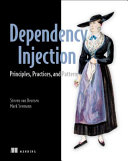Summary Dependency Injection Principles, Practices, and Patterns teaches you to use DI to reduce hard-coded dependencies between application components. You’ll start by learning what DI is and what types of applications will benefit from it. Then, you’ll work through concrete scenarios using C# and the .NET framework to implement DI in your own projects. As you dive into the thoroughly-explained examples, you’ll develop a foundation you can apply to any of the many DI libraries for .NET and .NET Core. Purchase of the print book includes a free eBook in PDF, Kindle, and ePub formats from Manning Publications. About the Technology Dependency Injection (DI) is a great way to reduce tight coupling between software components. Instead of hard-coding dependencies, such as specifying a database driver, you make those connections through a third party. Central to application frameworks like ASP.NET Core, DI enables you to better manage changes and other complexity in your software. About the Book Dependency Injection Principles, Practices, and Patterns is a revised and expanded edition of the bestselling classic Dependency Injection in .NET. It teaches you DI from the ground up, featuring relevant examples, patterns, and anti-patterns for creating loosely coupled, well-structured applications. The well-annotated code and diagrams use C# examples to illustrate principles that work flawlessly with modern object-oriented languages and DI libraries. What’s Inside Refactoring existing code into loosely coupled code DI techniques that work with statically typed OO languages Integration with common .NET frameworks Updated examples illustrating DI in .NET Core About the Reader For intermediate OO developers. About the Authors Mark Seemann is a programmer, software architect, and speaker who has been working with software since 1995, including six years with Microsoft. Steven van Deursen is a seasoned .NET developer and architect, and the author and maintainer of the Simple Injector DI library. Table of Contents PART 1 Putting Dependency Injection on the map The basics of Dependency Injection: What, why, and how Writing tightly coupled code Writing loosely coupled code PART 2 Catalog DI patterns DI anti-patterns Code smells PART 3 Pure DI Application composition Object lifetime Interception Aspect-Oriented Programming by design Tool-based Aspect-Oriented Programming PART 4 DI Containers DI Container introduction The Autofac DI Container The Simple Injector DI Container The Microsoft.Extensions.DependencyInjection DI Container

